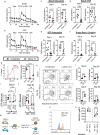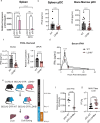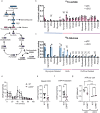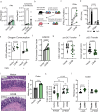Metabolic deficiencies underlie reduced plasmacytoid dendritic cell IFN-I production following viral infection
- PMID: 39920132
- PMCID: PMC11805920
- DOI: 10.1038/s41467-025-56603-5
Metabolic deficiencies underlie reduced plasmacytoid dendritic cell IFN-I production following viral infection
Abstract
Type I Interferons (IFN-I) are central to host protection against viral infections, with plasmacytoid dendritic cells (pDC) being the most significant source, yet pDCs lose their IFN-I production capacity following an initial burst of IFN-I, resulting in susceptibility to secondary infections. The underlying mechanisms of these dynamics are not well understood. Here we find that viral infection reduces the capacity of pDCs to engage both oxidative and glycolytic metabolism. Mechanistically, we identify lactate dehydrogenase B (LDHB) as a positive regulator of pDC IFN-I production in mice and humans; meanwhile, LDHB deficiency is associated with suppressed IFN-I production, pDC metabolic capacity, and viral control following infection. In addition, preservation of LDHB expression is sufficient to partially retain the function of otherwise exhausted pDCs, both in vitro and in vivo. Furthermore, restoring LDHB in vivo in pDCs from infected mice increases IFNAR-dependent, infection-associated pathology. Our work thus identifies a mechanism for balancing immunity and pathology during viral infections, while also providing insight into the highly preserved infection-driven pDC inhibition.
© 2025. The Author(s).
Conflict of interest statement
Competing interests: E.I.Z. is in the Scientific Advisory Board of Primmune and AGS Therapeutics. All other authors declare no competing interests.
Figures






Update of
-
Metabolic Deficiencies Underlie Plasmacytoid Dendritic Cell Exhaustion After Viral Infection.bioRxiv [Preprint]. 2024 Mar 3:2024.02.28.582551. doi: 10.1101/2024.02.28.582551. bioRxiv. 2024. Update in: Nat Commun. 2025 Feb 07;16(1):1460. doi: 10.1038/s41467-025-56603-5. PMID: 38464328 Free PMC article. Updated. Preprint.
Similar articles
-
Metabolic Deficiencies Underlie Plasmacytoid Dendritic Cell Exhaustion After Viral Infection.bioRxiv [Preprint]. 2024 Mar 3:2024.02.28.582551. doi: 10.1101/2024.02.28.582551. bioRxiv. 2024. Update in: Nat Commun. 2025 Feb 07;16(1):1460. doi: 10.1038/s41467-025-56603-5. PMID: 38464328 Free PMC article. Updated. Preprint.
-
Natural Killer Cell Sensing of Infected Cells Compensates for MyD88 Deficiency but Not IFN-I Activity in Resistance to Mouse Cytomegalovirus.PLoS Pathog. 2015 May 8;11(5):e1004897. doi: 10.1371/journal.ppat.1004897. eCollection 2015 May. PLoS Pathog. 2015. PMID: 25954804 Free PMC article.
-
Type I interferon negatively controls plasmacytoid dendritic cell numbers in vivo.J Exp Med. 2011 Nov 21;208(12):2367-74. doi: 10.1084/jem.20110654. Epub 2011 Nov 14. J Exp Med. 2011. PMID: 22084408 Free PMC article.
-
Plasmacytoid dendritic cells in antiviral immunity and autoimmunity.Sci China Life Sci. 2010 Feb;53(2):172-82. doi: 10.1007/s11427-010-0045-0. Epub 2010 Mar 7. Sci China Life Sci. 2010. PMID: 20596824 Free PMC article. Review.
-
Sex Differences in Primary HIV Infection: Revisiting the Role of TLR7-Driven Type 1 IFN Production by Plasmacytoid Dendritic Cells in Women.Front Immunol. 2021 Aug 27;12:729233. doi: 10.3389/fimmu.2021.729233. eCollection 2021. Front Immunol. 2021. PMID: 34512664 Free PMC article. Review.
Cited by
-
Aging-associated changes in immunological parameters: Implications for COVID-19 immune response in the elderly.Physiol Rep. 2025 May;13(10):e70364. doi: 10.14814/phy2.70364. Physiol Rep. 2025. PMID: 40405557 Free PMC article. Review.
-
Genomic analysis of progenitors in viral infection implicates glucocorticoids as suppressors of plasmacytoid dendritic cell generation.Proc Natl Acad Sci U S A. 2025 May 6;122(18):e2410092122. doi: 10.1073/pnas.2410092122. Epub 2025 Apr 28. Proc Natl Acad Sci U S A. 2025. PMID: 40294270
-
Tumor-Associated Macrophages: Polarization, Immunoregulation, and Immunotherapy.Cells. 2025 May 19;14(10):741. doi: 10.3390/cells14100741. Cells. 2025. PMID: 40422244 Free PMC article. Review.
-
Systemic IFN-I Synergizes with Topical TLR7/8 Agonists to Suppress Metastatic Tumors.Research (Wash D C). 2025 Jun 21;8:0739. doi: 10.34133/research.0739. eCollection 2025. Research (Wash D C). 2025. PMID: 40547481 Free PMC article.
-
Dendritic cells: understanding ontogeny, subsets, functions, and their clinical applications.Mol Biomed. 2025 Sep 8;6(1):62. doi: 10.1186/s43556-025-00300-8. Mol Biomed. 2025. PMID: 40924040 Free PMC article. Review.
References
MeSH terms
Substances
Grants and funding
LinkOut - more resources
Full Text Sources
Medical
Molecular Biology Databases
Miscellaneous

